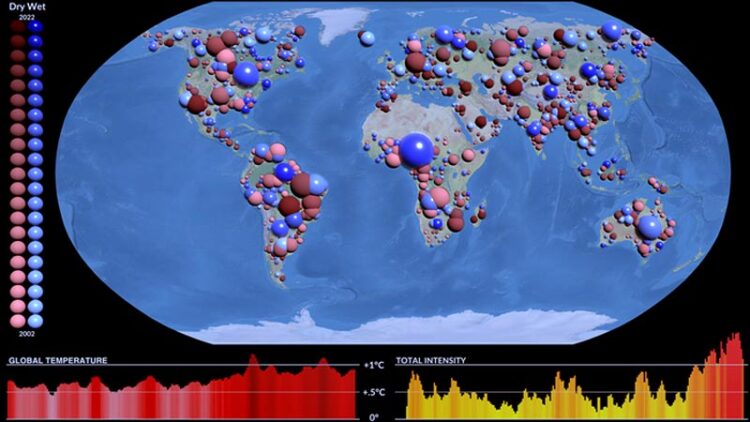Warming makes droughts, extreme wet events more frequent, intense

This visualization shows extremes of the water cycle — droughts and pluvials — over a twenty-year period (2002-2021) based on observations from the GRACE and GRACE-FO satellites.
Credit: NASA's Scientific Visualization Studio
Scientists have predicted that droughts and floods will become more frequent and severe as our planet warms and climate changes, but detecting this on regional and continental scales has proven difficult. Now a new NASA-led study confirms that major droughts and pluvials – periods of excessive precipitation and water storage on land – have indeed been occurring more often.
In the study published March 13, 2023, in the journal Nature Water, two NASA scientists examined 20 years of data from the NASA/German GRACE and GRACE-FO satellites to identify extreme wet and dry events. Floods and droughts account for more than 20% of the economic losses caused by extreme weather events in the U.S. each year. The economic impacts are similar around the world, though the human toll tends to be most devastating in poor neighborhoods and developing nations.
The scientists also found that the worldwide intensity of these extreme wet and dry events – a metric that combines extent, duration, and severity – is closely linked to global warming.
From 2015-2021 – seven of the nine warmest years in the modern record – the frequency of extreme wet and dry events was four per year, compared with three per year in the previous 13 years. This makes sense, say the authors, because warmer air causes more moisture to evaporate from Earth’s surface during dry events; warm air can also hold more moisture to fuel severe snowfall and rainfall events.
Rodell and study co-author Bailing Li of Goddard studied 1,056 extreme wet and dry events from 2002 to 2021, as observed by the Gravity Recovery and Climate Experiment (GRACE) and GRACE-Follow-On (GRACE-FO) satellites. The satellites use precise measurements of Earth’s gravity field to detect water storage anomalies — specifically, how the amount of water stored in soils, aquifers, lakes, rivers, snow cover, and ice compares to normal.
“It’s like watching the level of the water in your bathtub,” Rodell said. “You can see how much it rises and falls without knowing the total amount of water in the tub.” Because GRACE and GRACE-FO provide a new map of water storage anomalies around the world every month, they provide a comprehensive view of the severity of hydrological events and how they evolve over time.
In their study, Rodell and Li applied an “intensity” metric that accounts for the severity, duration, and spatial extent of droughts and extreme wet events. They found the global total intensity of extreme events increased from 2002 to 2021, mirroring Earth’s rising temperatures over the same period.
By far the most intense event identified in the study was a pluvial that began in 2019 in central Africa and is still ongoing. It has caused the level of Lake Victoria to rise by more than one meter. A 2015-2016 drought in Brazil was the most intense dry event of the past two decades, leading to empty reservoirs, and water rationing across some Brazilian cities.
“Both events were associated with climate variability, but the Brazilian drought occurred in the warmest year on record (2016), reflecting the impact of global warming,” said Bailing Li, a University of Maryland hydrologist at Goddard. “The recent southwestern U.S. and southern Europe droughts were also some of the most intense events, in part, due to anthropogenic warming.”
“Global warming has had broad and profound impacts on terrestrial water storage, such as reduction of annual snow in high elevations and depletion of groundwater by people when surface waters are scarce,” Li added. “Reflecting these changes, GRACE data provide us a unique perspective of how hydrological extremes have been changing around the world.”
“The idea of climate change can be abstract. A couple of degrees warmer doesn’t sound like much, but water cycle impacts are tangible,” said Matt Rodell, study co-author and a hydrologist at NASA’s Goddard Space Flight Center in Greenbelt, Maryland. “Global warming is going to cause more intense droughts and wet periods, which affects people, the economy, and agriculture around the world. Monitoring hydrological extremes is important for preparing for future events, mitigating their impacts, and adapting.”
Journal: Nature Water
Media Contact
Peter Jacobs
NASA/Goddard Space Flight Center
peter.jacobs@nasa.gov
Office: 301-286-0535
All latest news from the category: Ecology, The Environment and Conservation
This complex theme deals primarily with interactions between organisms and the environmental factors that impact them, but to a greater extent between individual inanimate environmental factors.
innovations-report offers informative reports and articles on topics such as climate protection, landscape conservation, ecological systems, wildlife and nature parks and ecosystem efficiency and balance.
Newest articles

Durable, Efficient, Sustainable: The Rise of Cerium Oxide Thermal Switches
Groundbreaking cerium oxide-based thermal switches achieve remarkable performance, transforming heat flow control with sustainable and efficient technology. Cerium Oxide-Based Thermal Switches Revolutionize Heat Flow Control Thermal switches, which electrically control…

How Industrial Robots are Reducing Emissions in Global Manufacturing
A new study explores the intersection of industrial automation and environmental sustainability, focusing on the role of industrial robots in reducing the carbon intensity of manufacturing exports. The research demonstrates…

Patients Can Heal Through Precise, Personalized Bioceramic Grafts
A recent review is transforming the landscape of craniomaxillofacial bone regeneration with the introduction of personalized bioceramic grafts. This pioneering research explores the fabrication and clinical potential of synthetic grafts…



